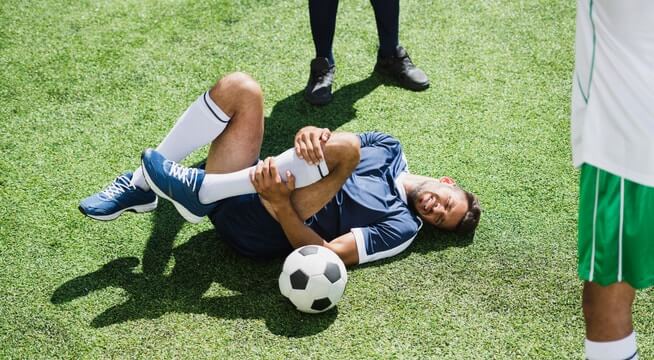The 6 Most Common Soccer Injuries & How to Treat Them
Sports Injuries
•
Sep 16, 2019

If your child plays sports, then bumps, scrapes, and bruises are typically a part of their routine. From falling to coming into contact with other players, getting hurt is never fun, but sometimes it’s inevitable. When it comes to the most dangerous sports, football is usually the first that comes to mind – but what about European football? In 2017, soccer resulted in 218,926 injuries compared to football’s 341,150. What are some of the most common soccer injuries, and how can you treat them?
Most Common Soccer Injuries
1. Strains and Sprains
From twisted ankles to knees, sprains and strains are very common in soccer. They usually occur from a sudden stop in movement and sharp directional turns. While most strains and sprains are minor injuries that require rest, pain relief medication, and ice packs, other cases can be more extreme.
Some injuries result in ACL tears where the anterior cruciate ligament is torn or detached from the joint. Symptoms include swelling, tenderness, an inability to extend the injured leg, and the knee giving out. When this happens, the pain can be incredibly severe, and a trip to an urgent clinic should be your next step. There, a doctor will provide a brace and sometimes crutches — depending on the severity of the tear — and prescribe pain relief medications. Based on the severity of the injury, physical therapy or surgery may also be required.
2. Shin Splints
Sometimes when the intensity or duration of training has changed, shin splints may occur in the front of the lower leg. This can occur from soreness in the calf or tight muscles in the leg. Symptoms include numb feet, pain along the inner part of the lower leg, and pain on either side of the shins.
When this happens, pain medication can provide temporary relief while stretching can alleviate symptoms over a few days. To prevent this from occurring, you should make sure your loved one is stretching before and after physical activity. If the shin splints happen frequently or last for more than a few days, you may want to visit your doctor to get further recuperation instructions.
3. Tendinitis
Sometimes your body will react to injuries with inflammation. This is often known as tendinitis and occurs when there has been an injury to a tendon and microtears in the muscle fiber occurs. This typically happens when the tendons are being overused.
Tendinitis may cause pain, tenderness, and mild swelling at the site of the tendon and surrounding area, or in some cases loss of motion. The skin in the injured area may also feel warm to the touch. If your loved one is experiencing tendinitis, they should rest the injured area and take anti-inflammatory medications. Icing the area on the day of the injury will also promote a speedy recovery.
4. Fractures
Running into other players or hitting the ground hard can often result in an ankle, arm, wrist, or other fractures. Depending on the severity and location of your broken bone, a trip to urgent care should be your first step. Symptoms of a fracture include sharp pain, substantial swelling, bruising, and loss of range of motion. If the fracture occurred on a lower extremity, an inability to bear weight on the affected leg or foot may occur. It’s also possible to actually hear the bone crack or pop at the time of the injury.
A doctor will conduct an x-ray to determine the severity of the injury, and provide a brace to help the bone mend. This may result in follow-up appointments to get a more permanent cast or monitor the progression of the healing bone. These types of injuries may prevent your loved one from playing soccer for several weeks.
5. Dermal Injuries
While some dermal injuries may result in a quick trip to the sidelines for a medical kit, others require more immediate attention. Some deep cuts require stitches. If your loved one has a deep laceration, then you should go to an urgent care facility as soon as possible.
An urgent care clinic will be able to clean the wound, and quickly stitch the laceration to minimize scarring and exposure. Some stitches will require follow-up visits for removal, while others can dissolve on their own.
6. Head Injuries
Head-on collisions can be extremely dangerous. While some minor injuries may result in headaches or nausea, other extreme head injuries can result in concussions. This causes brain trauma, which involves headaches, loss of consciousness, dizziness, and often memory loss.
If your loved one has come in contact with another player and displays signs of a concussion — including trouble focusing their eyes, dizziness, memory loss, and sluggishness — you should take them to an emergency room immediately. A physician will need to monitor their brain activity with a CT scan or MRI and ensure the brain is not swollen or damaged. In some extreme cases, your loved one may be kept overnight in a hospital. Otherwise, instructions will be provided for a speedy recovery. Rest is key when a head injury occurs.
Urgent Care Services in Colorado Springs and Texas
If you or a loved one have been injured playing soccer or another sport, we can provide the care you need. If you have questions or need immediate treatment, your nearest Complete Care location is ready to help, no matter the time of day or night. We offer a variety of services to help you and your family in your time of need. No appointments are necessary.
Find the Complete Care location nearest you.